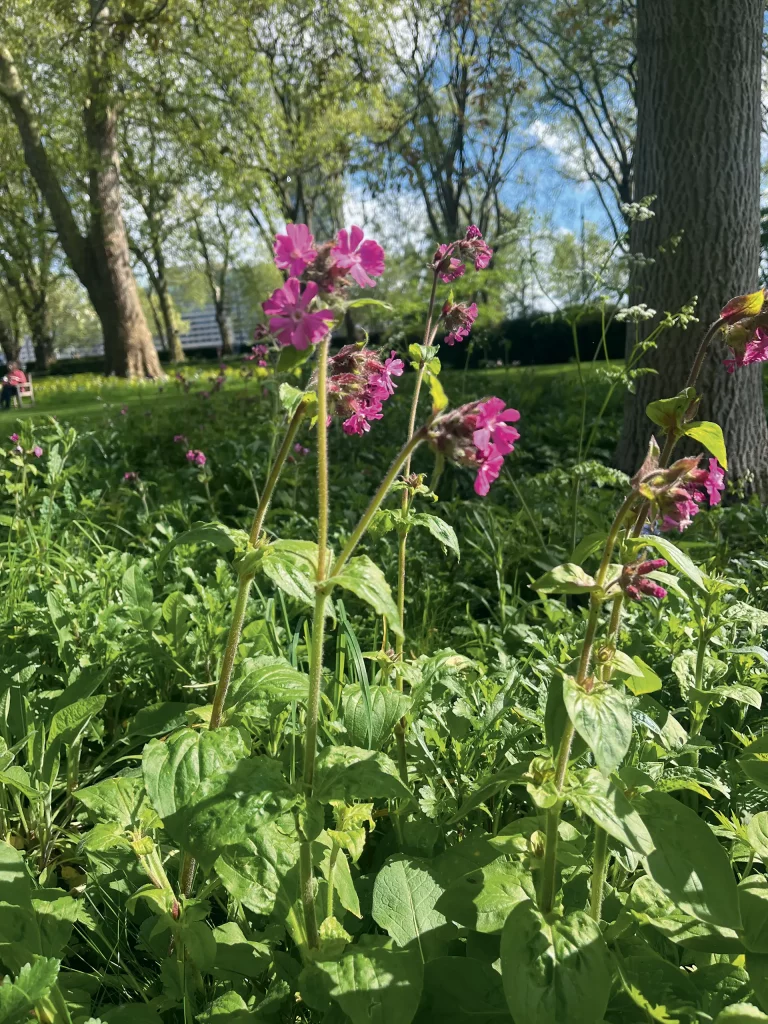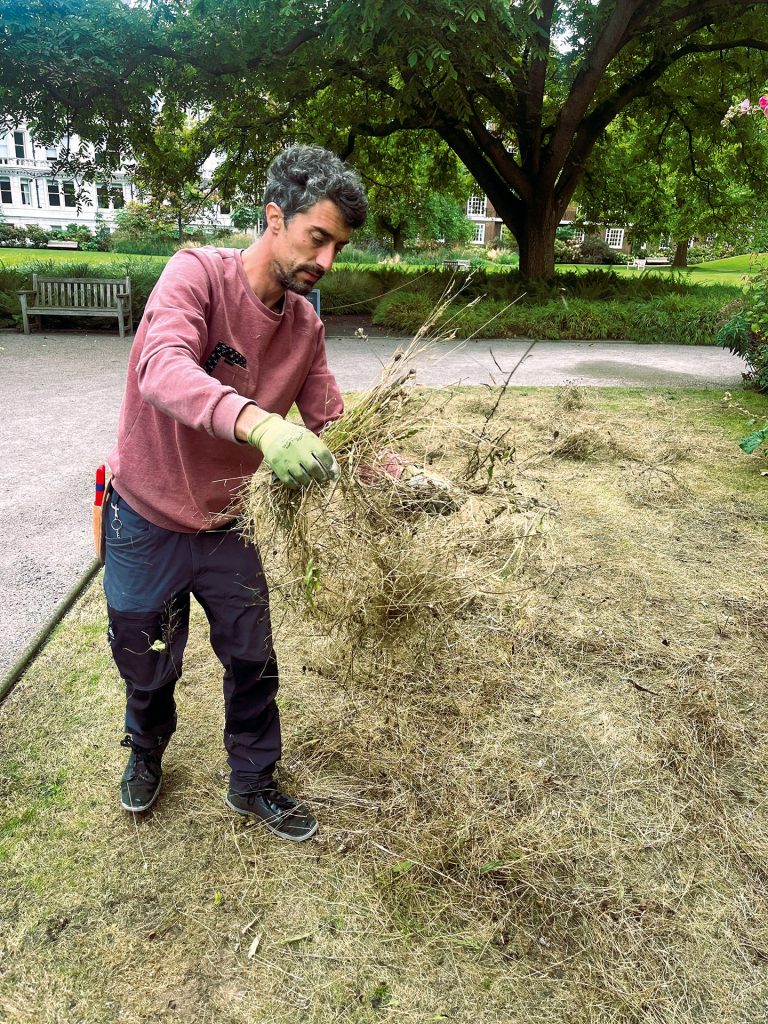
ICLR
If it's reportable, we report it.


Back in the spring, I travelled to County Kerry, the southernmost tip of Ireland, to visit relatives and to hike Carrantuohill, Ireland’s highest peak. My mum grew up on a farm on the Ring of Kerry, an area of outstanding natural beauty with stunning mountains, lakes and coastline. The combination of the gulf stream and a range of landscapes and soils creates an environment that hosts an extraordinary range of flora and fauna.
Childhood summers were spent on the family farm with our cousins, playing on the ditch or swimming in the river when the weather was kind. I did not realise at the time how influential being surrounded by such beauty was, though when I return I am overwhelmed by the landscape, wildflowers, forests, mosses and lichens. For me, such natural beauty awakens a real sense of calm and awe.

Back in the City, much of the work that has taken place in the Garden over recent years has been to soften and develop a greater sense of nature and an element of wildness as a juxtaposition to the buildings and location. The benefit this brings in terms of biodiversity has further expanded my sense of ‘beauty’. Rather than old fashioned notions of sterile formality, there is more beauty in thinking of the Garden as a living entity, nourishing all the senses and providing a home for birds, pollinators and invertebrates. A garden full of life bringing with it a sense of awe and joy.

There is more beauty in thinking of the Garden as a living entity, nourishing all the senses and providing a home for birds, pollinators and invertebrates. A garden full of life bringing with it a sense of awe and joy.

I am encouraged by the growing appreciation for plants that have traditionally been thought of as weeds and wildflowers. The simple beauty and the many benefits they bring to the Garden are now being acknowledged. Like all gardening it is about balance, and careful decision making.

ICLR
If it's reportable, we report it.
Trusted law reporting since 1865
My favourite moments in the Garden are the spontaneous wildflowers dancing in the borders, connecting with the meadow and long grass areas. In the borders, this requires identifying the young self-sown seedlings and rather than weeding them out or spraying toxic weedkiller, allowing the seedlings to come through, moving into new positions or adding seeds into specific locations to look as though they have found themselves there. A favourite plant ident for our trainee and the team is always the seedling ident, and the discussions of which seedlings we will encourage and where. I am proud to say the Garden and Estate teams at The Inner Temple do not use glyphosate weedkiller which is detrimental to pollinators and blanket kills all seedlings regardless of what they are.

The Garden felt rather static before the Valarian, Valariana officinalis popping through the borders, with its tall, pink-tinged white flowers smelling of jasmine, which in turn form the most beautiful coral formed seedhead. Native to Britain, across Europe to Northwest Iran, Valariana officinalis is happy in sun or part shade, and often cited as enjoying a moist soil. It does, though we find it equally happy once germinated in dry soils also. It makes the most wonderful link plant across the Garden as it works in our differing conditions, from the heat of the High Border to the shade of the Broadwalk. Often covered in aphid without affecting the plant and so offering a food source to ladybirds, the flowers are also beneficial for a range of pollinators including butterflies, bee species and hoverflies.

The Garden is also much richer for the delicate grace that Cow Parsley, Anthriscus sylvestris brings with its cream frothy umbels defining the shift from spring into summer. The swaying umbels in the borders help blur the boundary between the more cultivated and the natural. The native distribution is remarkable, across the whole of Europe, northern Asia and the mountains of East Africa. It supports a range of bees and hoverflies, in addition to the orange tip butterfly and the common brindled brown moth. We find it gently self-seeds and we encourage new colonies by scattering seed in areas.

Another favourite, which previously has been considered a weed is Ribwort Plantain, Plantago lanceolata. This is not the larger relative known as Greater Plantain, Plantago major, which has wide flat leaves. We continue to weed this out of the lawn where it colonises if left unchecked. Plantago lanceolota, in contrast, has thin leaves and long stems with a pale cone flower on top, which I find very elegant. In addition, it is beneficial to moths, hoverflies and a food source for the caterpillars of the Heath Fritillary and Granville Fritillary butterflies.

It was with great excitement in June that we spotted for the first time in the meadow something rather more special, Bee Orchids, Ophrys apifera. Though small, this stunning native orchid mimics a female bee in marking and scent to encourage pollination. Terrestrial orchids require certain mycorrhiza fungi in the soil and so this is promising. I hope there will be swathes of native orchids in our meadow areas in years to come.

I could go on all day about my favourite wildflowers and how much the Garden is richer for the presence of the striking mauve thistle flowers and seedheads of Teasel, Dipsacus fullonum; the sunshine yellow of the Meadow Buttercup, Ranunculus acris; and the flirty pink of the Red Campion, Silene diocia. I have been inspired this year by the huge difference across the Capital in how our green spaces are managed, with many more areas cultivated for wildflowers, long grass and a rejection of spraying toxic weedkiller. It is so nice for the Garden to be part of a growing ecological gardening community across the Capital and beyond. For those interested, they should follow the work of John Little in Essex, Richard Scott in Liverpool, and of Benny Hawksbee at the Eden Community Garden in Clapham.

Back to my recent trip to Ireland, where I was introduced to the work of the Irish writer and philosopher John Moriarty (1938–2007), who was born and lived in Kerry. He wrote extensively throughout his life on nature and spirituality. In an interview he talks about the importance of wildness, he clarifies that this isn’t law breaking or anarchy, but the importance of keeping an element of unshapen wildness inside as part of who we are.

I hope that the beauty of the wildflowers in the Garden helps keep this connection to positive wildness for those who use it. I love seeing members take off their shoes for a walk across the lawn, or others using the Garden for morning tai chi or to sit and take a moment. It feels as if the Garden is helping those visitors to connect to the special wildness within.

This article also marks our Garden rainee, Stefano Ciabo, leaving the Inn on completing his two-year traineeship for a coveted place on the Kew Diploma. Stefano has been involved in many of the projects to develop the wildflowers in the Garden over this time and also leaves his mark across the Inn with his amiable personality and infectious passion for gardening. We wish him all the best for what will be a bright future. As one academic term closes and a new one starts, it is great to look forward. The team and I have plans to add more wildflowers to the Garden and we hope you enjoy the beauty they will bring.

Sean Harkin
Head Gardener
